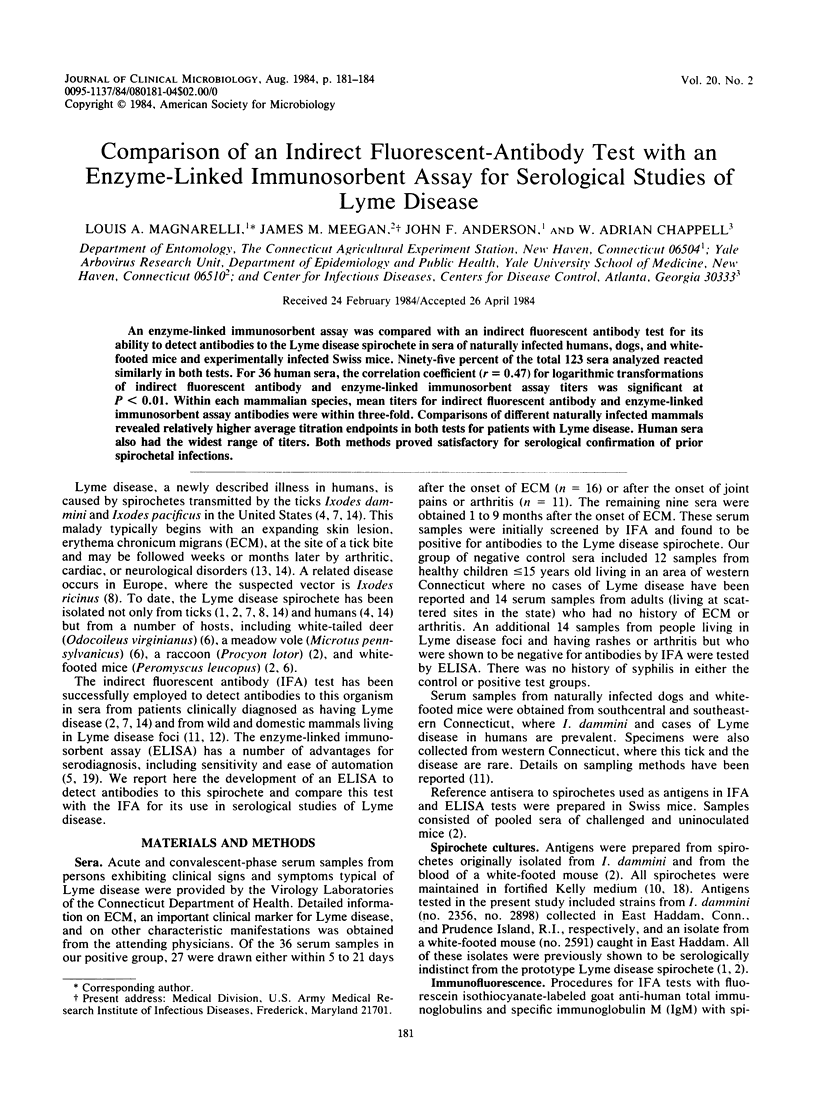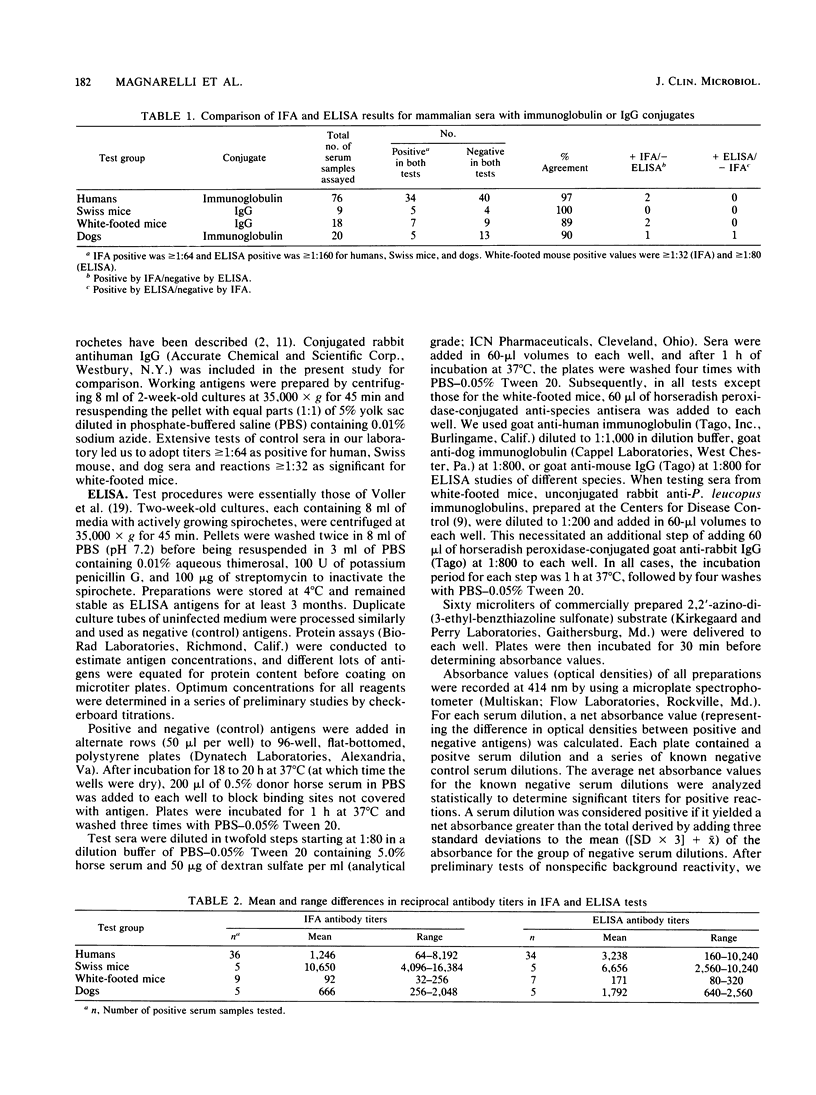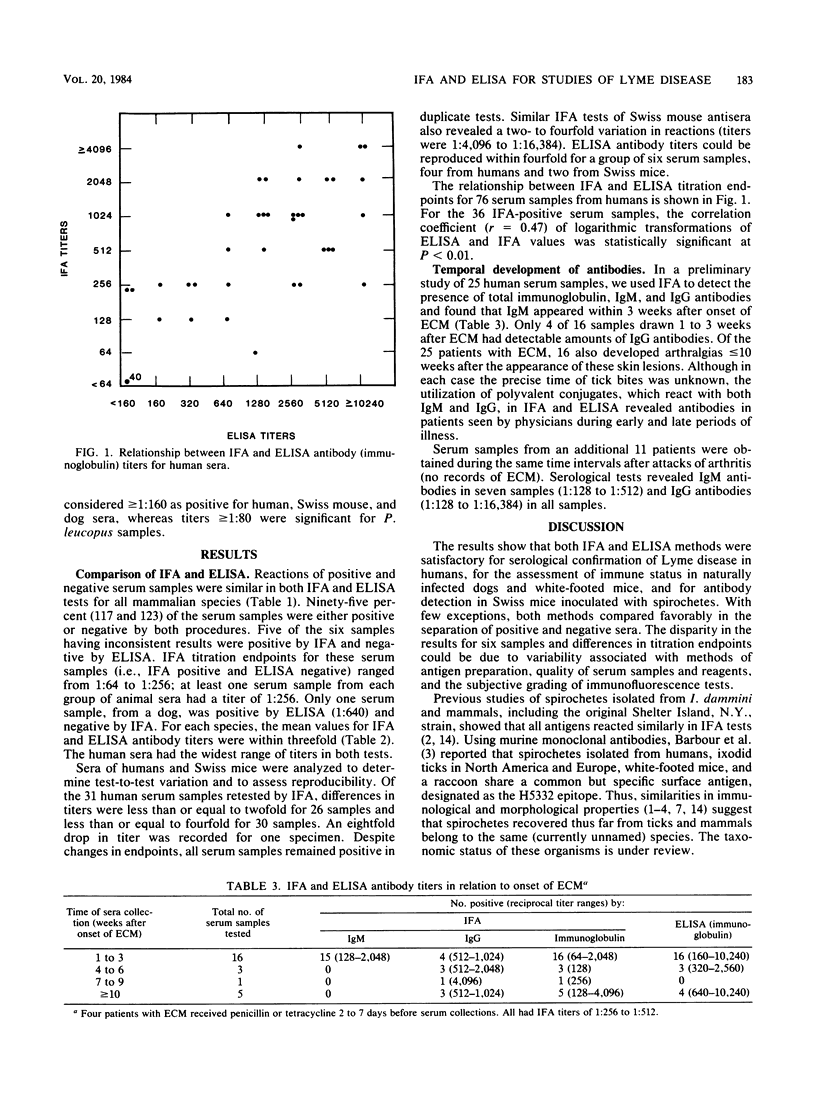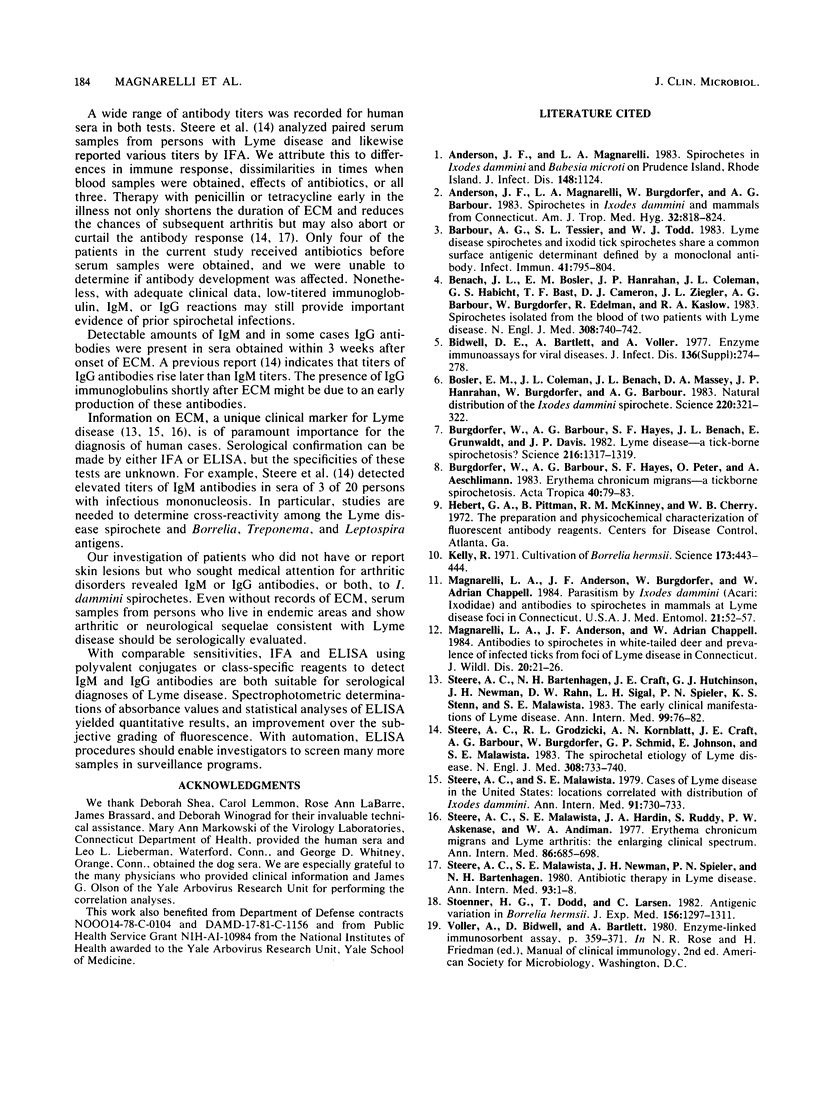Abstract
An enzyme-linked immunosorbent assay was compared with an indirect fluorescent antibody test for its ability to detect antibodies to the Lyme disease spirochete in sera of naturally infected humans, dogs, and white-footed mice and experimentally infected Swiss mice. Ninety-five percent of the total 123 sera analyzed reacted similarly in both tests. For 36 human sera, the correlation coefficient (r = 0.47) for logarithmic transformations of indirect fluorescent antibody and enzyme-linked immunosorbent assay titers was significant at P less than 0.01. Within each mammalian species, mean titers for indirect fluorescent antibody and enzyme-linked immunosorbent assay antibodies were within three-fold. Comparisons of different naturally infected mammals revealed relatively higher average titration endpoints in both tests for patients with Lyme disease. Human sera also had the widest range of titers. Both methods proved satisfactory for serological confirmation of prior spirochetal infections.
Full text
PDF



Selected References
These references are in PubMed. This may not be the complete list of references from this article.
- Anderson J. F., Magnarelli L. A., Burgdorfer W., Barbour A. G. Spirochetes in Ixodes dammini and mammals from Connecticut. Am J Trop Med Hyg. 1983 Jul;32(4):818–824. doi: 10.4269/ajtmh.1983.32.818. [DOI] [PubMed] [Google Scholar]
- Anderson J. F., Magnarelli L. A. Spirochetes in Ixodes dammini and Babesia microti on Prudence Island, Rhode Island. J Infect Dis. 1983 Dec;148(6):1124–1124. doi: 10.1093/infdis/148.6.1124. [DOI] [PubMed] [Google Scholar]
- Barbour A. G., Tessier S. L., Todd W. J. Lyme disease spirochetes and ixodid tick spirochetes share a common surface antigenic determinant defined by a monoclonal antibody. Infect Immun. 1983 Aug;41(2):795–804. doi: 10.1128/iai.41.2.795-804.1983. [DOI] [PMC free article] [PubMed] [Google Scholar]
- Benach J. L., Bosler E. M., Hanrahan J. P., Coleman J. L., Habicht G. S., Bast T. F., Cameron D. J., Ziegler J. L., Barbour A. G., Burgdorfer W. Spirochetes isolated from the blood of two patients with Lyme disease. N Engl J Med. 1983 Mar 31;308(13):740–742. doi: 10.1056/NEJM198303313081302. [DOI] [PubMed] [Google Scholar]
- Bosler E. M., Coleman J. L., Benach J. L., Massey D. A., Hanrahan J. P., Burgdorfer W., Barbour A. G. Natural Distribution of the Ixodes dammini spirochete. Science. 1983 Apr 15;220(4594):321–322. doi: 10.1126/science.6836274. [DOI] [PubMed] [Google Scholar]
- Burgdorfer W., Barbour A. G., Hayes S. F., Benach J. L., Grunwaldt E., Davis J. P. Lyme disease-a tick-borne spirochetosis? Science. 1982 Jun 18;216(4552):1317–1319. doi: 10.1126/science.7043737. [DOI] [PubMed] [Google Scholar]
- Burgdorfer W., Barbour A. G., Hayes S. F., Péter O., Aeschlimann A. Erythema chronicum migrans--a tickborne spirochetosis. Acta Trop. 1983 Mar;40(1):79–83. [PubMed] [Google Scholar]
- Kelly R. Cultivation of Borrelia hermsi. Science. 1971 Jul 30;173(3995):443–444. doi: 10.1126/science.173.3995.443. [DOI] [PubMed] [Google Scholar]
- Magnarelli L. A., Anderson J. F., Burgdorfer W., Chappell W. A. Parasitism by Ixodes dammini (Acari: Ixodidae) and antibodies to spirochetes in mammals at Lyme disease foci in Connecticut, USA. J Med Entomol. 1984 Jan 26;21(1):52–57. doi: 10.1093/jmedent/21.1.52. [DOI] [PubMed] [Google Scholar]
- Magnarelli L. A., Anderson J. F., Chappell W. A. Antibodies to spirochetes in white-tailed deer and prevalence of infected ticks from foci of Lyme disease in Connecticut. J Wildl Dis. 1984 Jan;20(1):21–26. doi: 10.7589/0090-3558-20.1.21. [DOI] [PubMed] [Google Scholar]
- Steere A. C., Bartenhagen N. H., Craft J. E., Hutchinson G. J., Newman J. H., Rahn D. W., Sigal L. H., Spieler P. N., Stenn K. S., Malawista S. E. The early clinical manifestations of Lyme disease. Ann Intern Med. 1983 Jul;99(1):76–82. doi: 10.7326/0003-4819-99-1-76. [DOI] [PubMed] [Google Scholar]
- Steere A. C., Grodzicki R. L., Kornblatt A. N., Craft J. E., Barbour A. G., Burgdorfer W., Schmid G. P., Johnson E., Malawista S. E. The spirochetal etiology of Lyme disease. N Engl J Med. 1983 Mar 31;308(13):733–740. doi: 10.1056/NEJM198303313081301. [DOI] [PubMed] [Google Scholar]
- Steere A. C., Malawista S. E. Cases of Lyme disease in the United States: locations correlated with distribution of Ixodes dammini. Ann Intern Med. 1979 Nov;91(5):730–733. doi: 10.7326/0003-4819-91-5-730. [DOI] [PubMed] [Google Scholar]
- Steere A. C., Malawista S. E., Hardin J. A., Ruddy S., Askenase W., Andiman W. A. Erythema chronicum migrans and Lyme arthritis. The enlarging clinical spectrum. Ann Intern Med. 1977 Jun;86(6):685–698. doi: 10.7326/0003-4819-86-6-685. [DOI] [PubMed] [Google Scholar]
- Steere A. C., Malawista S. E., Newman J. H., Spieler P. N., Bartenhagen N. H. Antibiotic therapy in Lyme disease. Ann Intern Med. 1980 Jul;93(1):1–8. doi: 10.7326/0003-4819-93-1-1. [DOI] [PubMed] [Google Scholar]
- Stoenner H. G., Dodd T., Larsen C. Antigenic variation of Borrelia hermsii. J Exp Med. 1982 Nov 1;156(5):1297–1311. doi: 10.1084/jem.156.5.1297. [DOI] [PMC free article] [PubMed] [Google Scholar]


